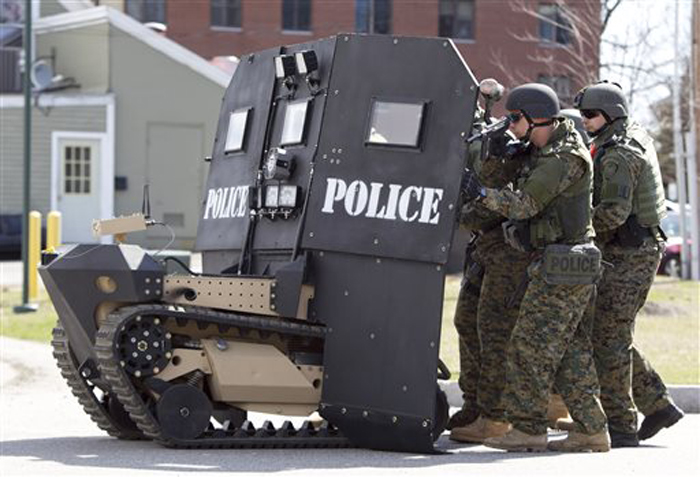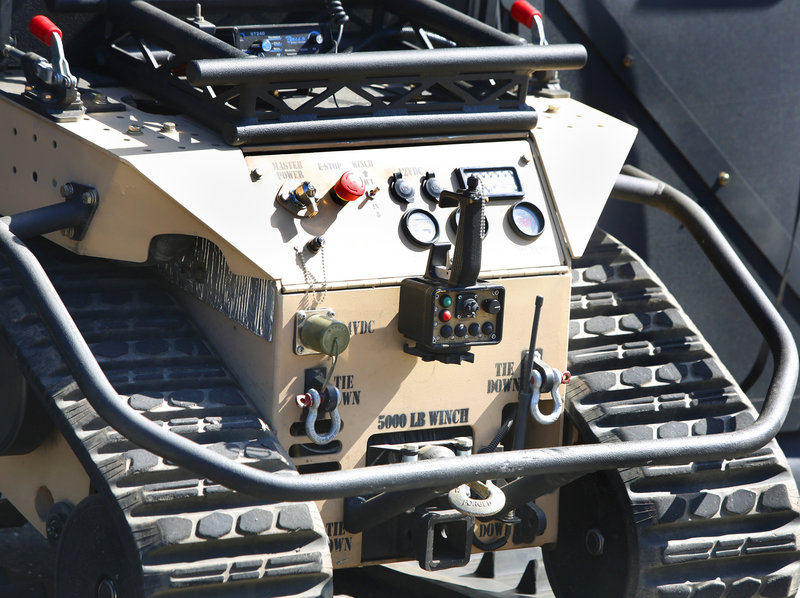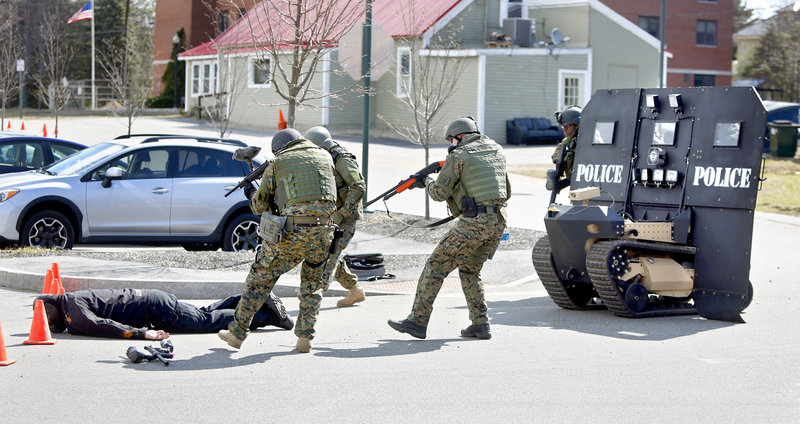SANFORD — Howe and Howe Technologies, known for developing unmanned, remoted-controlled robotic tanks for the U.S. military and cool toys for Hollywood blockbusters, has shifted its focus to a new device intended to protect the law enforcement community.
The company’s new, $100,000 robot, known as the SWAT-Bot, is bullet- and bomb-resistant and acts as a mobile shield to protect up to 12 officers in dangerous situations. The robot can move towards a target at up to 5 miles per hour, emitting piercing sirens and blinding lights to disorient an attacker.
The device’s various attachments can smash and remove doors, puncture tires to immobilize a vehicle, or even drag away a car that might be obstructing a crime scene.
The robot was developed in conjunction with the Massachusetts State Police’s Special Tactical Operations Team (STOP Team). It was supposed to be unveiled this week in Boston, but that plan was scrapped after the Boston Marathon bombings, and the robot was introduced at the Sanford Police Station on Thursday.
“This is the future of tactical approach to save the lives of citizens and police domestically,” said Mike Howe, president of Howe and Howe. The Boston bombings make “it even more paramount that we protect our first responders and civilians.”
The SWAT-Bot, or robotic ballistic shield, would not have been able to stop the bombings in Boston, but it could help in future emergencies if a suspicious package needed to be remotely examined with a camera and safely removed or covered with a ballistic mat, said Geoff Howe, chief executive of the Waterboro-based company.
The SWAT-Bot “is not meant to replace an officer or first responder but to assist and protect them in their work,” said Geoff Howe.
The robot was developed after Massachusetts State Police saw the company’s Thermite device, a compact fire-fighting robot capable of fighting fires involving hazardous materials or in situations where it is unsafe for a firefighter to go. State police wanted to fill an apparent gap in protection between body armor and ballistics shields and larger, more expensive armored vehicles, Mike Howe said.
The SWAT-Bot, which also got development input from the Southern Maine Special Response Team, was developed over two to three years. Howe and Howe self-funded the research and development, using the profits from its military work. The company did not disclose total development costs.
“The economic environment of the U.S. has been in question for some time. Sequestration is making it difficult for municipalities to do their job,” said Mike Howe. “How much does it cost when an officer goes down? I consider this to be an investment in safety.”
The SWAT-Bot’s price tag equals roughly the annual salary of two policemen, he said.
Sanford Police Chief Thomas Connolly said his department cannot afford a SWAT-Bot, but he sees the advantage of using a robot like it in a dangerous situation.
“If you had a mentally ill person on a porch, armed and acting erratic, you could drive right up to them safely and deploy a taser. You could get close to someone while protecting both sides,” Connolly said.
Massachusetts State Police would not say if it plans to purchase a SWAT-Bot.
Howe and Howe builds and designs all parts of its devices in house. The company currently has no contracts to build more than its demonstration unit, but it hopes to get state, local or federal authorities to invest in the SWAT-Bot starting this summer.
“The more we sell, the more we can lower the price,” said Mike Howe. “We’re breaking into the future. It’s a tough step. The first sale is the hardest part.”
Howe and Howe Technologies, led by the twin brothers, also does more than develop military and safety devices.
Geoff and Mike Howe have completed two seasons of their own reality TV show called “Black Ops Brothers, Howe and Howe Tech,” which aired on the Discovery Channel.
A modified version of their Ripsaw unmanned remote-controlled tank was featured in “G.I. Joe: Retaliation,” which was released this year, and one of their tanks will be used in a planned remake of “Mad Max.”
Staff Writer Jessica Hall can be contacted at 791-6316 or at:
jhall@pressherald.com
Send questions/comments to the editors.






